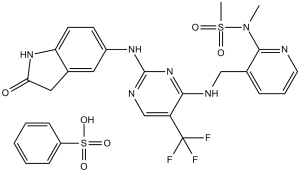This product is for research use only, not for human use. We do not sell to patients.

| Size | Price | Stock |
|---|---|---|
| 250mg | $750 | Check With Us |
| 500mg | $1150 | Check With Us |
| 1g | $1725 | Check With Us |
Cat #: V0656 CAS #: 939791-38-5 Purity ≥ 98%
Description: PF-00562271 besylate (also called PF562271 or PF-562271 Besylate), the benzenesulfonate salt form of PF-00562271, is an ATP-competitive and orally bioavailable inhibitor of FAK (focal adhesion kinase) and Pyk2 catalytic activity with potential antitumor activity. It inhibits FAK and Pyk2 with IC50s of 1.5 and 14 nmol/L, respectively. It demonstrates high in vivo antitumor efficacy against multiple human xenograft models.
References: [1]. Roberts WG, et al. Antitumor activity and pharmacology of a selective focal adhesion kinase inhibitor, PF-562,271. Cancer Res, 2008, 68(6), 1935-1944.
Publications Citing InvivoChem Products
Product Promise

- Physicochemical and Storage Information
- Protocol
- Related Biological Data
- Stock Solution Preparation
- Quality Control Documentation
| Molecular Weight (MW) | 665.66 |
|---|---|
| Molecular Formula | C21H20F3N7O3S.C6H6O3S |
| CAS No. | 939791-38-5 |
| Storage | -20℃ for 3 years in powder formr |
| -80℃ for 2 years in solvent | |
| Solubility In Vitro | DMSO: 14 mg/mL (21.0 mM)r |
| Water: <1 mg/mLrr | |
| Ethanol: <1 mg/mL | |
| Solubility In Vivo | 4% DMSO+30% PEG 300+ddH2O: 3 mg/mL |
| SMILES Code | CS(=O)(N(C)C1=NC=CC=C1CNC2=NC(NC3=CC4=C(NC(C4)=O)C=C3)=NC=C2C(F)(F)F)=O.O=S(C5=CC=CC=C5)(O)=O |
| Synonyms | PF-562271; PF-562271 Besylate; PF562271; PF-00562271; PF00562271; PF 00562271; PF562271 PhSO3H; PF562271 benzesulfonate salt; PF-271; PF271; PF271; |
| Protocol | In Vitro | In vitro activity: PF-562271 shows the selective inhibitory effects on FAK and Pyk2 tyrosine kinase activity with IC50 of 1.5 nM and 14 nM, respectively. And in cell-based assays, the IC50 of PF-562271 is shown to be 5 nM for FAK, which is more selective compared to other kinase targets. In 2 dimensional (2D) cultures, PF-562271 results in a dose-dependent cell proliferation inhibition in FAK WT, FAK−/− and FAK kinase-deficient (KD) cells with IC50 of 3.3 μM, 2.08 μM and 2.01 μM, respectively. Kinase Assay: PF-562271 shows the selective inhibitory effects on FAK and Pyk2 tyrosine kinase activity with IC50 of 1.5 nM and 14 nM, respectively. And in cell-based assays, the IC50 of PF-562271 is shown to be 5 nM for FAK, which is more selective compared to other kinase targets. In 2 dimensional (2D) cultures, PF-562271 results in a dose-dependent cell proliferation inhibition in FAK WT, FAK−/− and FAK kinase-deficient (KD) cells with IC50 of 3.3 μM, 2.08 μM and 2.01 μM, respectively. Cell Assay: Cells (Squamous cell carcinoma (SCC) are plated for 48 hours before addition of PF-562271. After 3 days cells are fixed by addition of ice cold 25% trichloroacetic acid (TCA) solution prior to staining with Sulforhodamine B (SRB) dye solution. Plates are washed with 1% glacial acetic acid, air-dried and resuspended in 10 mM Tris buffer, pH 10.5 before reading absorbance at 540 nm. Curve fitting and generation of IC50 values is carried out using GraphPad Prism 4 software from six replicates. |
|---|---|---|
| In Vivo | In several human s.c. xenograft models, PF-562271 exhibits dose-dependent tumor growth inhibition, and produces maximum tumor inhibition for PC-3M, BT474, BxPc3, and LoVo ranging from 78% to 94% inhibition at doses of 25 to 50 mg/kg twice daily, without weight loss, morbidity, or death. PF-562271 (25 mg/kg by p.o.) leads to a significant decrease in tumor progression in both subcutaneous and bone metastasis PC3M-luc-C6 xenograft models. In a Huh7.5 hepatocellular carcinoma xenograft model, combination therapy of sunitinib and PF-562271 targets angiogenesis and tumor aggressiveness, and produces more significant anti-tumor effect than single agent by blocking tumor growth and impacting the ability of the tumor to recover upon withdrawal of the therapy. | |
| Animal model | PC-3M, BT474, BxPc3, LoVo, U87MG, H125 and H460 cells are injected s.c. into the right flank of athymic female mice | |
| Formulation | Dissolved in in 5% Gelucie | |
| Dosages | 100 mg/kg; Oral gavage |
| Solvent volume to be added | Mass (the weight of a compound) | |||
|---|---|---|---|---|
| Mother liquor concentration | 1mg | 5mg | 10mg | 20mg |
| 1mM | 1.5023 mL | 7.5113 mL | 15.0227 mL | 30.0454 mL |
| 5mM | 0.3005 mL | 1.5023 mL | 3.0045 mL | 6.0091 mL |
| 10mM | 0.1502 mL | 0.7511 mL | 1.5023 mL | 3.0045 mL |
| 20mM | 0.0751 mL | 0.3756 mL | 0.7511 mL | 1.5023 mL |
This equation is commonly abbreviated as: C1 V1 = C2 V2
- (1) Please be sure that the solution is clear before the addition of next solvent. Dissolution methods like vortex, ultrasound or warming and heat may be used to aid dissolving.
- (2) Be sure to add the solvent(s) in order.






































